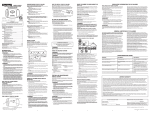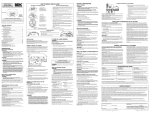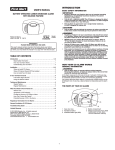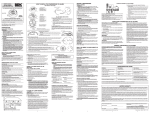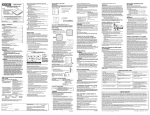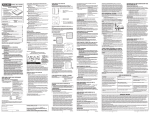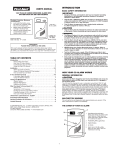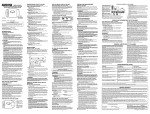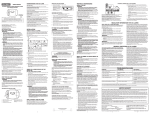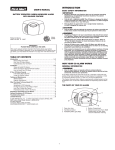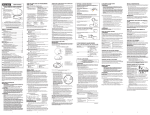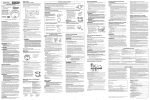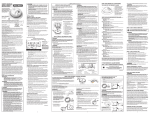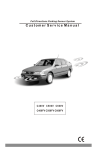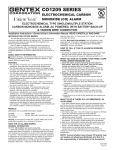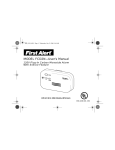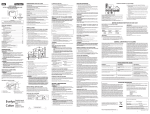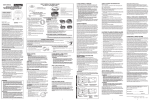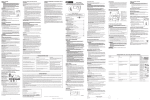Transcript
WHAT YOU WILL SEE AND HEAR WITH THIS ALARM
USER’S MANUAL
10 YEAR CARBON MONOXIDE ALARM
WITH VOICE & LOCATION
UL STD 2034
Model CO910V
TABLE OF CONTENTS
Introduction . . . . . . . . . . . . . . . . . . . . . . . . . . . . . . . . . . . . . . . . . . . . .1
Basic Safety Information . . . . . . . . . . . . . . . . . . . . . . . . . . . . . . .1
Step By Step Guide to Programming This Alarm . . . . . . . . . . . . .1-2
What You Will See and Hear With This Alarm . . . . . . . . . . . . . . .2
Installation . . . . . . . . . . . . . . . . . . . . . . . . . . . . . . . . . . . . . . . . . . . . .2-3
Where to Install This Alarm . . . . . . . . . . . . . . . . . . . . . . . . . . . . . .2
Where This Alarm Should NOT Be Installed . . . . . . . . . . . . . . . .2
How to Install This Alarm . . . . . . . . . . . . . . . . . . . . . . . . . . . . . . .3
If Your CO Alarm Sounds . . . . . . . . . . . . . . . . . . . . . . . . . . . . . . . . .3-4
If the CO Alarm Sounds . . . . . . . . . . . . . . . . . . . . . . . . . . . . . . . .3
Using the Silence Features . . . . . . . . . . . . . . . . . . . . . . . . . . . . . .4
Weekly Testing . . . . . . . . . . . . . . . . . . . . . . . . . . . . . . . . . . . . . . . . . . .4
Regular Maintenance . . . . . . . . . . . . . . . . . . . . . . . . . . . . . . . . . . . . .4
To Permanently Deactivate the CO Alarm . . . . . . . . . . . . . . . . . . . . .4
What You Need To Know About CO . . . . . . . . . . . . . . . . . . . . . . . .4-5
What is CO? . . . . . . . . . . . . . . . . . . . . . . . . . . . . . . . . . . . . . . . . .4
Symptoms of CO Poisoning . . . . . . . . . . . . . . . . . . . . . . . . . . .4-5
Potential Sources of CO in the Home . . . . . . . . . . . . . . . . . . . . .5
How Can I Protect My Family From CO Poisoning? . . . . . . . . . . . .5
Regulatory Information For CO Alarms . . . . . . . . . . . . . . . . . . . . . . .6
General Limitations Of CO Alarms . . . . . . . . . . . . . . . . . . . . . . . . . . .6
Troubleshooting Guide . . . . . . . . . . . . . . . . . . . . . . . . . . . . . . . . . . .5-6
Limited Warranty . . . . . . . . . . . . . . . . . . . . . . . . . . . . . . . . . . . . . . .5-6
© 2013 BRK Brands, Inc. All rights reserved.
Distributed by BRK Brands, Inc.
3901 Liberty Street Road, Aurora, IL 60504-8122
Consumer Affairs: (800) 323-9005 • www.firstalert.com
INTRODUCTION
BASIC SAFETY INFORMATION
• Dangers, Warnings, and Cautions alert you to important
operating instructions or to potentially hazardous situations.
Pay special attention to these items.
• This CO Alarm is approved for use in single-family
residences. It is NOT designed for marine or RV use.
1
2
3
STEP BY STEP GUIDE TO PROGRAMMING
THIS ALARM
For First Time and When Activating Alarm
Alarm Will Say:
“Welcome, First Alert Carbon
Monoxide Alarm.”
“No location programmed” if first
time or “[Location, example:
“Kitchen”] location programmed”
after activating Alarm.
“To select location, press and
hold test button now.”
2. Press & Hold Test Button if
you would like to program the
location or change the location
of the Alarm. Release button
after Alarm responds.
“To save location, press and hold
test button after location is
heard.” Alarm will speak list of
locations (see below).
3. After you hear the location of
where you are placing the
Alarm, Press & Hold the Test
Button.
“[Location, example: “Kitchen”]
location saved.”
If no location is chosen: “No
location saved.”
Your Alarm has now been programmed for the location of your choice.
Available locations:
Basement
Hallway
Office
Child’s Bedroom
Kitchen
Utility Room
Dining Room
Living Room
Family Room
Master Bedroom
Guest Bedroom
No Location
Alarm Levels of CO are Detected
Voice: “Warning, evacuate carbon monoxide in [Location, example:
“Kitchen”]. Evacuate.” “____ ppm.”
Horn: 4 beeps, pause, 4 beeps, voice*
LED: Flashes Red
*NOTE: If unit goes into CO alarm, the regular 4 beeps-brief pause
cycle will repeat for four minutes. After four minutes, the pause will
increase to one minute.
INSTALLATION
Mounting bracket
Mounting slots
WHERE TO INSTALL THIS ALARM
Tools you will need: pencil, drill with 3/16” or 5mm drill bit,
flathead screwdriver, hammer.
NOTE: Be sure to mount the product in the orientation specified in
the next steps as this provides the most stability for mounting the
product to the wall. This CO Alarm can either be wall mounted or
placed on a tabletop.
NOTE: For added protection, install an additional CO Alarm at least
15 feet (4.6 meters) away from the furnace or fuel burning heat source
where possible. In smaller homes or in manufactured homes where this
distance cannot be maintained, install the Alarm as far away as possible
from the furnace or other fuel burning source. Installing the Alarm closer
than 15 feet (4.6 meters) will not harm the Alarm, but may increase the
frequency of unwanted alarms.
In general, install Carbon Monoxide Alarms:
• On every level of your home, including finished attics and basements.
• In the hall near every sleeping area. If a hall is more than 40 feet (12
meters) long, install a unit at each end.
• At the top of first-to-second floor stairs.
• At the bottom of the basement stairs.
• For additional coverage, install Alarms in all rooms, halls, and
storage areas, where temperatures normally remain between 40˚ F
and 100˚ F (4.4˚ C and 37.8˚ C).
Recommended Placement
SUGGESTED AREAS FOR INSTALLING
SMOKE ALARMS, CO ALARMS, AND COMBO UNITS
KEY:
SMOKE ALARM WITH
SILENCE FEATURE
CO ALARMS
BOTH, OR COMBINATION
SMOKE/CO ALARMS
Suggested locations are based on
NFPA recommendations (NFPA 72
for Smoke Alarms and NFPA 720 for
Carbon Monoxide Alarms). Always
refer to national and local codes
before beginning any installation.
In new construction AC and AC/DC smoke alarms MUST
be interconnected to meet NFPA recommendations.
NOTE: For any location, make sure no door or other obstruction could
keep carbon monoxide from reaching the Alarm.
Installing CO Alarms in Mobile Homes
For minimum security install one Smoke/CO Alarm as close to each
sleeping area as possible. For more security, put one unit in each room.
Many older mobile homes (especially those built before 1978) have little
or no insulation. If your mobile home is not well insulated, or if you are
unsure of the amount of insulation, it is important to install units on
inside walls only.
3. Hold the mounting bracket against the wall
so the arrow located on the mounting plate
is pointing to the left. (The circular shape will
now be in upper right-hand corner). Trace
around the insides of the mounting slots.
4. Put the unit where it won’t get covered with
dust when you drill the mounting holes.
5. Using a 3/16” (5 mm) drill bit, drill a hole through the center of the
oval outlines you traced in step #3.
6. Insert the plastic screw anchors (in the plastic bag with screws) into
the holes. Tap the screw anchors gently with a hammer, if necessary,
until they are flush with the wall.
7. Attach the mounting bracket to the wall.
8. Activate the battery. Move the activation switch to
center position against tab stop. Unit will not mount OFF - ON - DISCHARGE
on mounting bracket unless activated. Once unit is
activated, it cannot be turned off.
NOTE: After you activate the battery, the power indicator light may
flash. (If the unit alarms, the light will blink rapidly, and the horn will
repeatedly sound 4 beeps, pause, 4 beeps.)
9. Attach the CO Alarm to the mounting
bracket. Line up the arrow on the back
of the unit to the arrow on the mounting
bracket. When the units are lined up,
slide the alarm to the right until it snaps
into place.
NOTE: Once the CO Alarm is snapped
onto the mounting bracket, you can
rotate CO Alarm to adjust the alignment.
10. Test the Alarm. See “Weekly Testing.”
TABLETOP PLACEMENT:
Your CO Alarm may also be placed on a tabletop by fastening the 2
stands provided. If using this approach, be sure the Alarm is no more
than 3 feet (0.9 meters) from the floor to minimize the risk of causing
permanent damage to the Alarm in the event it accidently falls to the
ground.
IF YOUR CO ALARM SOUNDS
What You See and Hear
Do NOT locate this CO Alarm:
• In garages, furnace rooms, crawl spaces and unfinished attics.
Avoid extremely dusty, dirty or greasy areas.
• Where combustion particles are produced. Combustion particles
form when something burns. Areas to avoid include poorly ventilated
kitchens, garages, and furnace rooms. Keep units at least 20 feet
(6 meters) from the sources of combustion particles (stove, furnace,
water heater, space heater) if possible. In areas where a 20-foot
(6 meter) distance is not possible – in modular, mobile, or smaller
homes, for example – it is recommended the Alarm be placed as
far from these fuel-burning sources as possible. The placement
recommendations are intended to keep these Alarms at a
reasonable distance from a fuel-burning source, and thus reduce
“unwanted” alarms. Unwanted alarms can occur if a CO Alarm is
placed directly next to a fuel-burning source. Ventilate these areas
as much as possible.
• In direct sunlight.
• In turbulent air, like near ceiling fans or open windows. Blowing air
may prevent CO from reaching the sensors.
• In areas where temperature is colder than 40˚ F (4.4˚C) or hotter
than 100˚ F (37.8˚C). These areas include non-airconditioned crawl
spaces, unfinished attics, uninsulated or poorly insulated ceilings,
porches, and garages.
• In insect infested areas. Insects can clog the openings to the
sensing chamber.
• Less than 12 inches (305 mm) away from fluorescent lights.
Electrical “noise” can interfere with the sensor.
• In “dead air” spaces. See “Avoiding Dead Air Spaces”.
Carbon Monoxide (CO)
Voice: “Warning, evacuate carbon
monoxide in [Location,
example: “Kitchen”].
Evacuate.” “____ ppm.”
Horn: 4 beeps, pause, 4 beeps,
voice
LED: Flashes Red
When it is necessary to reprogram the Alarm after the unit has been
activated and is in normal operation: Tap the Test button 5 times to
reset the Alarm to again access the programming menu.
Date Purchased: _________________
Replace alarm 10 years after installation. Please write the date in
the space provided:
_____________/____________Month/Year
Where Purchased: __________________________________
The alarm will also provide an audible End-of-Life Signal
approximately 10 years after installation to remind you to
replace the unit.
Date Installed: ____________/____________Month/Year
The End-of-Life Signal can be silenced for up to 2 days.
Do not unplug or deactivate the alarm until you get replacement.
2. Press & Hold Test Button, if you
would like to clear the highest
level sensed.
If you would like to keep the
highest level in memory, do
not press anything.
“Highest carbon monoxide level
cleared.”
Alarm will say nothing.
Never deactivate the unit to quiet an unwanted alarm. Deactivating
the alarm disables the unit and removes your protection.
The Silence Feature is intended to temporarily silence the horn while
you identify and correct the problem. Do not use the Silence Feature in
emergency situations. It will not correct a CO problem.
The Silence Feature can temporarily quiet an unwanted alarm for several
minutes. Press the Test/Silence button on the alarm cover for at least
3-5 seconds.
After the Test/Silence button is released, the Red LED blinks during the
silence mode.
SILENCING THE LOW BATTERY WARNING
Type of Alarm
“Dead air” spaces may prevent CO from reaching the CO Alarm.
To avoid dead air spaces, follow installation recommendations.
Alarm Will Say:
“Highest carbon monoxide level
was ___ ppm. Please see manual.”
“To clear highest carbon monoxide
level, press and hold test button
now.”
This silence feature can temporarily quiet the low battery warning
“chirp” for up to 8 hours. You can silence the low battery warning
“chirp” by pressing the Test/Silence button on the alarm cover.
Once the low battery warning “chirp” silence feature is activated, the
unit continues to flash the Green light once a minute for 8 hours. After
8 hours, the low battery “chirp” will resume. Replace the Alarm as
soon as possible; this unit will not operate without battery power!
To deactivate this feature: Press the Test/Silence button again. The
unit will go into Test Mode and the low battery warning will resume
(LED flashes and unit sounds “chirp” once a minute).
WHERE THIS ALARM SHOULD NOT BE INSTALLED
AVOIDING DEAD AIR SPACES
Action:
1. Press & Hold Test Button
When the CO Alarm is Silenced
The CO Alarm will remain silent for up to 4 minutes. After 4 minutes,
if CO levels remain potentially dangerous the horn will start sounding
again.
FOR WALL MOUNTING
FOLLOW THESE SIMPLE STEPS:
1. Turn alarm upside down so the circular
shape is located in the upper left corner of
the alarm.
2. Slide mounting bracket to the left and lift to
separate it from the base.
IF THE CO ALARM SOUNDS
“ALARM-MOVE TO FRESH AIR”
If you hear the CO alarm horn and the CO red light is flashing,
move everyone to a source of fresh air.
DO NOT deactivate the Alarm!
Actuation of your CO Alarm indicates the presence of carbon
monoxide (CO) which can kill you. In other words, when your CO
Alarm sounds, you must not ignore it!
IF THE CO ALARM SIGNAL SOUNDS:
1. Press the Test/Silence button.
2. Call your emergency services, fire department or 911. Write down
the number of your local emergency service here:
____________________________________________________________
3. Immediately move to fresh air—outdoors or by an open door or
window. Do a head count to check that all persons are accounted
for. Do not re-enter the premises, or move away from the open door
or window until the emergency services responder has arrived, the
premises have been aired out, and your CO Alarm remains in its
normal condition.
4. After following steps 1-3, if your CO Alarm reactivates within a
24-hour period, repeat steps 1-3 and call a qualified appliance
technician to investigate for sources of CO from fuel-burning
equipment and appliances, and inspect for proper operation of this
equipment. If problems are identified during this inspection have the
equipment serviced immediately. Note any combustion equipment
not inspected by the technician, and consult the manufacturers’
instructions, or contact the manufacturers directly, for more
information about CO safety and this equipment. Make sure that
motor vehicles are not, and have not, been operating in an attached
garage or adjacent to the residence. Write down the number of a
qualified appliance technician here:
____________________________________________________________
NOTE: A qualified appliance technician is defined as “a person, firm,
corporation, or company that either in person or through a representative, is engaged in and responsible for the installation, testing, servicing,
or replacement of heating, ventilation, air conditioning (HVAC) equipment,
combustion appliances and equipment, and/or gas fireplaces or other
decorative combustion equipment.”
REGULATORY INFORMATION FOR
CO ALARMS
SYMPTOMS OF CO POISONING, Continued
AFTER AN ALARM
After the emergency responders arrive, the premises aired out, and
your CO Alarm remains in its normal condition, you can check what
the highest carbon monoxide level sensed was:
USING THE SILENCE FEATURES
The National Fire Protection Association (NFPA) recommends that a CO
Alarm should be centrally located outside of each separate sleeping
area in the immediate vicinity of the bedrooms. For added protection,
install additional CO Alarms in each separate bedroom, and on every
level of your home.
For Reprogramming
For your records, please record:
1
2
Test/Silence Button
Power/CO Alarm LED
Speaker
Alarm has reached its End of Life
Voice: “Detector error in [Location, example “Basement”], please
see manual.” Repeated every 5 hours
Horn: 5 chirps every minute
LED: Five Green flashes approximately once a minute
• This carbon monoxide Alarm is designed to detect carbon
monoxide gas from ANY source of combustion. This CO Alarm
is not designed to detect smoke, fire, or any other gas. It will
only indicate the presence of carbon monoxide gas at the
sensor. Carbon monoxide gas may be present in other areas.
Action:
1. Activate Alarm (If the battery
has not been activated,
perform Step 8 on page 3).
PARTS OF THIS CO ALARM
If Alarm is Not Operating Properly
Voice: “Detector error in [Location, example “Kitchen”], please see
manual.” Repeated every 5 hours
Horn: 3 chirps every minute
LED: Three Green flashes approximately once a minute
SMOKE ALARMS
• This unit will not operate without battery power. The CO
Alarm cannot work until you activate the battery power pack.
• NEVER ignore any alarm. See “If Your CO Alarm Sounds” for
more information on how to respond to an alarm. Failure to
respond can result in injury or death.
• The Silence Features are for your convenience only and will
not correct a problem. See "Using the Silence Features" for
details. Always check your home for a potential problem
after any alarm. Failure to do so can result in injury or death.
• Test this CO Alarm once a week. If the Alarm ever fails to
test correctly, have it replaced immediately! If the Alarm is
not working properly, it cannot alert you to a problem.
• This product is intended for use in ordinary indoor locations
of family living units. It is not designed to measure CO levels
in compliance with Occupational Safety and Health
Administration (OSHA) commercial or industrial standards.
Individuals with medical conditions that may make them
more sensitive to carbon monoxide may consider using
warning devices which provide audible and visual signals for
carbon monoxide concentrations under 30 ppm. For additional information on carbon monoxide and your medical
condition contact your physician.
IF YOUR CO ALARM SOUNDS, Continued
This combination Smoke/CO Alarm was designed to be mounted on
the ceiling or wall. It is not a tabletop device. You must install this
device on the ceiling or wall as outlined below. Read “Where To Install
This Alarm” before starting.
If Battery Becomes Low
Voice: “Please see manual.” Repeated every 5 hours
Horn: chirps once a minute
Power LED: Flashes Green approximately once a minute
IMPORTANT! PLEASE READ CAREFULLY AND SAVE.
This user’s manual contains important information about your
Carbon Monoxide Alarm’s operation.
If you are installing this Alarm for use by others, you must leave
this manual—or a copy of it—with the end user.
CONFORMS TO
HOW TO INSTALL THIS ALARM
When You Test the Alarm
Voice: “Warning, evacuate carbon monoxide in [Location, example:
“Kitchen”]. Evacuate.”
Horn: 4 beeps, pause, 4 beeps, voice
LED: Flashes Red
Features:
• Voice with programmable location
• Audible and visual signals to
indicate alarm levels of CO
• Sealed-In Lithium
Battery — Sealed-in
lithium power supply;
no battery replacement required
over the 10 year life of the alarm.
Printed in Mexico
M08-0478-000 K1 09/13
Under Normal Operations
Voice: Silent
Power LED: Flashes Green once a minute
Horn: Silent
SILENCING THE END OF LIFE SIGNAL
This silence feature can temporarily quiet the End of Life warning
“chirp” for up to 2 days. You can silence the End of Life warning “chirp”
by pressing the Test/Silence button. The horn will chirp, acknowledging
that the End of Life silence feature has been activated.
After approximately 2 days, the End of Life “chirp” will resume.
This CO Alarm measures exposure to CO over time. It alarms if CO levels
are extremely high in a short period of time, or if CO levels reach a certain
minimum over a long period of time. The CO Alarm generally sounds an
alarm before the onset of symptoms in average, healthy adults. Why is this
important? Because you need to be warned of a potential CO problem while
you can still react in time. In many reported cases of CO exposure, victims
may be aware that they are not feeling well, but become disoriented and can
no longer react well enough to exit the building or get help. Also, young children and pets may be the first affected. The average healthy adult might not
feel any symptoms when the CO Alarm sounds. However, people with cardiac
or respiratory problems, infants, unborn babies, pregnant mothers, or elderly
people can be more quickly and severely affected by CO. If you experience
even mild symptoms of CO poisoning, consult your doctor immediately!
FINDING THE SOURCE OF CO AFTER AN ALARM
Carbon monoxide is an odorless, invisible gas, which often makes it difficult
to locate the source of CO after an alarm. These are a few of the factors that
can make it difficult to locate sources of CO:
• House well ventilated before the investigator arrives.
• Problem caused by “backdrafting.”
• Transient CO problem caused by special circumstances.
Because CO may dissipate by the time an investigator arrives, it may be
difficult to locate the source of CO. BRK Brands, Inc. shall not be obligated
to pay for any carbon monoxide investigation or service call.
POTENTIAL SOURCES OF CO IN THE HOME
Fuel-burning appliances like: portable
heater, gas or wood burning fireplace, gas
kitchen range or cooktop, gas clothes
dryer.
Damaged or insufficient venting:
corroded or disconnected water heater
vent pipe, leaking chimney pipe or flue,
or cracked heat exchanger, blocked or
clogged chimney opening.
Improper use of appliance/device:
operating a barbecue grill or vehicle
in an enclosed area (like a garage or
screened porch).
Transient CO Problems: “transient” or on-again-off-again CO problems can
be caused by outdoor conditions and other special circumstances.
The following conditions can result in transient CO situations:
1. Excessive spillage or reverse venting of fuel appliances caused by outdoor conditions such as:
• Wind direction and/or velocity, including high, gusty winds. Heavy air
in the vent pipes (cold/humid air with extended
periods between cycles).
• Negative pressure differential resulting from the use of exhaust fans.
• Several appliances running at the same time competing for limited
fresh air.
• Vent pipe connections vibrating loose from clothes dryers, furnaces,
or water heaters.
• Obstructions in or unconventional vent pipe designs which can amplify
the above situations.
2. Extended operation of unvented fuel burning devices (range, oven, fireplace).
3. Temperature inversions, which can trap exhaust close to the ground.
4. Car idling in an open or closed attached garage, or near a home.
These conditions are dangerous because they can trap exhaust in your home.
Since these conditions can come and go, they are also hard to recreate
during a CO investigation.
HOW CAN I PROTECT MY FAMILY FROM
CO POISONING?
WEEKLY TESTING
• NEVER use an open flame of any kind to test this unit. You
might accidentally damage or set fire to the unit or to your
home. NEVER use vehicle exhaust! Exhaust may cause
permanent damage and voids your warranty.
• DO NOT stand close to the Alarm when the horn is sounding.
Exposure at close range may be harmful to your hearing.
When testing, step away when horn starts sounding.
It is important to test this unit every week to make sure it is working
properly. Using the test button is the recommended way to test this
CO Alarm.
You can test this CO Alarm by pressing and holding the Test/Silence
button on the Alarm cover until Alarm Voice says “Testing” (typically
3-5 seconds).
During testing, you will see and hear the following sequence:
• The Horn will sound 4 beeps, pause, 4 beeps. The Alarm Voice
will say “Warning, evacuate carbon monoxide in [Location,
example: “Kitchen”]. Evacuate.” The POWER LED flashes Red.
If the unit does not alarm, make sure it has been activated correctly,
and test again. If the unit still does not alarm, replace it immediately.
REGULAR MAINTENANCE
This unit has been designed to be as maintenance-free as possible, but
there are a few simple things you must do to keep it working properly.
• Test it at least once a week.
• Clean the CO Alarm at least once a month; gently vacuum the
outside of the CO Alarm using your household vacuum’s soft brush
attachment. A can of clean compressed air (sold at computer or
office supply stores) may also be used. Follow manufacturer
instructions for use. Test the CO Alarm. Never use water, cleaners
or solvents since they may damage the unit.
• If the CO Alarm becomes contaminated by excessive dirt, dust
and/or grime, and cannot be cleaned to avoid unwanted alarms,
replace the unit immediately.
• Relocate the unit if it sounds frequent unwanted alarms. See
“Where This Alarm Should Not Be Installed” for details.
A CO Alarm is an excellent means of protection. It monitors the air and
sounds a loud alarm before Carbon Monoxide levels become threatening for
average, healthy adults.
A CO Alarm is not a substitute for proper maintenance of home appliances.
To help prevent CO problems and reduce the risk of CO poisoning:
• Clean chimneys and flues yearly. Keep them free of debris, leaves,
and nests for proper air flow. Also, have a professional check for rust
and corrosion, cracks, or separations. These conditions can prevent
proper air movement and cause backdrafting. Never “cap” or cover a
chimney in any way that would block air flow.
• Test and maintain all fuel-burning equipment annually. Many local gas
or oil companies and HVAC companies offer appliance inspections for
a nominal fee.
• Make regular visual inspections of all fuel-burning appliances. Check
appliances for excessive rust and scaling. Also check the flame on
the burner and pilot lights. The flame should be blue. A yellow flame
means fuel is not being burned completely and CO may be present.
Keep the blower door on the furnace closed. Use vents or fans when
they are available on all fuel-burning appliances. Make sure appliances
are vented to the outside. Do not grill or barbecue indoors, or in
garages or on screen porches.
• Check for exhaust backflow from CO sources. Check the draft hood
on an operating furnace for a backdraft. Look for cracks on furnace
heat exchangers.
• Check the house or garage on the other side of shared wall.
• Keep windows and doors open slightly. If you suspect that CO is
escaping into your home, open a window or a door. Opening windows
and doors can significantly decrease CO levels.
In addition, familiarize yourself with all enclosed materials. Read this
manual in its entirety, and make sure you understand what to do if your
CO Alarm sounds.
2
Standards: Underwriters Laboratories Inc. Single and Multiple Station
carbon monoxide alarms UL2034.
According to Underwriters Laboratories Inc. UL2034, Section 1-1.2: “Carbon
monoxide alarms covered by these requirements are intended to respond to
the presence of carbon monoxide from sources such as, but not limited to,
exhaust from internal-combustion engines, abnormal operation of fuel-fired
appliances, and fireplaces. CO Alarms are intended to alarm at carbon
monoxide levels below those that could cause a loss of ability to react to the
dangers of Carbon Monoxide exposure.” This CO Alarm monitors the air at
the Alarm, and is designed to alarm before CO levels become life threatening.
This allows you precious time to leave the house and correct the problem.
This is only possible if Alarms are located, installed, and maintained as
described in this manual.
Gas Detection at Typical Temperature and Humidity Ranges: The CO
Alarm is not formulated to detect CO levels below 30 ppm typically. UL
tested for false alarm resistance to Methane (500 ppm), Butane (300 ppm),
Heptane (500 ppm), Ethyl Acetate (200 ppm), Isopropyl Alcohol (200 ppm)
and Carbon Dioxide (5000 ppm). Values measure gas and vapor concentrations in parts per million.
Audible Alarm: 85 dB minimum at 10 feet (3 meters).
GENERAL LIMITATIONS OF CO ALARMS
This CO Alarm is intended for residential use. It is not intended for use in
industrial applications where Occupational Safety and Health Administration
(OSHA) requirements for Carbon Monoxide Alarms must be met. This device
is not intended to alert hearing impaired residents. CO Alarms are not yet
available for the hearing impaired.
CO Alarms may not waken all individuals. Practice the escape plan at
least twice a year, making sure that everyone is involved – from kids to
grandparents. Allow children to master fire escape planning and practice
before holding a fire drill at night when they are sleeping. If children or others
do not readily waken to the sound of the CO Alarm, or if there are infants or
family members with mobility limitations, make sure that someone is
assigned to assist them in the event of an emergency. It is recommended
that you hold a fire drill while family members are sleeping in order to
determine their response to the sound of the CO Alarm while sleeping and to
determine whether they may need assistance in the event of an emergency.
This CO Alarm will not sense CO that does not reach the sensors. It will
only sense CO at the sensor. CO may be present in other areas. Doors or
other obstructions may affect the rate at which CO reaches the sensors.
If bedroom doors are usually closed at night, we recommend you install a
CO Alarm in each bedroom and in the hallway between them.
This CO Alarm may not sense CO on another level of the home.
Example: This alarm device, installed on the second floor, may not sense CO
in the basement. For this reason, one alarm device may not give adequate
early warning.
CO Alarms may not be heard. The alarm horn loudness meets or exceeds
current UL standards of 85 dB at 10 feet (3 meters). However, if the CO
Alarm is installed outside the bedroom, it may not wake up a sound sleeper
or one who has recently used drugs or has been drinking alcoholic beverages. This is especially true if the door is closed or only partly open. Even
persons who are awake may not hear the alarm horn if the sound is blocked
by distance or closed doors. Noise from traffic, stereo, radio, television, air
conditioner, or other appliances may also prevent alert persons from hearing
the alarm horn. This CO Alarm is not intended for people who are hearing
impaired.
This CO Alarm is not a substitute for life insurance. Though this CO Alarm
warns against increasing CO levels, BRK Brands, Inc. does not warrant or
imply in any way that they will protect lives. Homeowners and renters must
still insure their lives.
This CO Alarm has a limited life. Although this CO Alarm and all of its parts
have passed many stringent tests and are designed to be as reliable as
possible, any of these parts could fail at any time. Therefore, you must test
this device weekly. The unit should be replaced immediately if it is not
operating properly.
This CO Alarm is not foolproof. Like all other electronic devices, this CO
Alarm has limitations. It can only detect CO that reaches the sensors. It may
not give early warning of the source of CO is in a remote part of the home,
away from the alarm device.
TROUBLESHOOTING GUIDE
Problem...
You should...
Horn "chirps" about once per minute;
Voice: "Please see manual" every 5 hours
Low battery warning.
Immediately replace the Alarm.
Horn sounds three "chirps" every minute;
Voice: "Detector error in [Location, example
"Kitchen"], please see manual" repeated every
5 hours; LED has 3 Green flashes with "chirps".
MALFUNCTION SIGNAL. Device is not
working properly, and needs to be replaced.
Units under warranty should be returned to
manufacturer for replacement. See “Limited
Warranty” for details.
The light flashes GREEN and the horn sounds 5
“chirps” every minute;
Voice: "Detector error in [Location, example
"Basement"], please see manual." Repeated
every 5 hours.
END OF LIFE SIGNAL. Alarm needs to be
replaced.
Immediately replace the Alarm.
Actual battery service life depends on the CO Alarm and the environment
in which it is installed. Regardless of the manufacturer’s suggested
battery life, you MUST replace the Alarm immediately once the unit
starts “chirping” (the “low battery warning”).
TO PERMANENTLY DEACTIVATE THE CO ALARM
CO Alarm goes back into alarm 4 minutes after
you Silence it.
CO levels indicate a potentially dangerous
situation.
After 10 years of operation or Low Battery
warning, deactivate the Alarm: Insert a tool
below edge where shown and break tab.
Then slide activation switch to discharge mode.
IF YOU ARE FEELING SYMPTOMS OF CO
POISONING, EVACUATE your home and call
911 or the Fire Department. Refer to "If The CO
Alarm Sounds" for details.
CO Alarm sounds frequently even though no high
levels of CO are revealed in an investigation.
The CO Alarm may be improperly located. Refer
to “Where to Install This Alarm” for details.
NOTE: At end of life or low battery indication (chirp): unit must be
put in to deactivation mode to discharge remaining stored energy
in battery. Unit will no longer function once put into this mode.
Unit will resist re-mounting.
Relocate your Alarm. If frequent alarms
continue, have home rechecked for potential
CO problems. You may be experiencing an
intermittent CO problem.
If you have questions that cannot be answered by reading this manual, call Consumer Affairs at 1-800-323-9005, M-F 7:30 a.m. to 5:00 p.m. (CST)
WHAT YOU NEED TO KNOW ABOUT CO
WHAT IS CO?
CO is an invisible, odorless, tasteless gas produced when fossil fuels
do not burn completely, or are exposed to heat (usually fire). Electrical
appliances typically do not produce CO.
These fuels include: Wood, coal, charcoal, oil, natural gas, gasoline,
kerosene, and propane.
Common appliances are often sources of CO. If they are not properly
maintained, are improperly ventilated, or malfunction, CO levels can
rise quickly. CO is a real danger now that homes are more energy
efficient. “Air-tight” homes with added insulation, sealed windows,
and other weatherproofing can “trap” CO inside.
SYMPTOMS OF CO POISONING
These symptoms are related to CO POISONING and should be
discussed with ALL household members.
Mild Exposure: Slight headache, nausea, vomiting, fatigue (“flu-like”
symptoms).
Medium Exposure: Throbbing headache, drowsiness, confusion, fast
heart rate.
Extreme Exposure: Convulsions, unconsciousness, heart and lung
failure. Exposure to Carbon Monoxide can cause brain damage, death.
Continued...
Continued...
3
CO Alarms are designed to alarm before there is an immediate life threat.
Since you cannot see or smell CO, never assume it’s not present.
• An exposure to 100 ppm of CO for 20 minutes may not affect average,
healthy adults, but after 4 hours the same level may cause headaches.
• An exposure to 400 ppm of CO may cause headaches in average,
healthy adults after 35 minutes, but can cause death after 2 hours.
If the Alarm...
LIMITED WARRANTY
BRK Brands, Inc., ("BRK") the maker of First Alert® brand products warrants that for a period of ten years from the date of purchase, this product will
be free from defects in material and workmanship. BRK, at its option, will repair or replace this product or any component of the product found to be
defective during the warranty period. Replacement will be made with a new or remanufactured product or component. If the product is no longer available,
replacement may be made with a similar product of equal or greater value. This is your exclusive warranty. This warranty is valid for the original retail
purchaser from the date of initial retail purchase and is not transferable. Keep the original sales receipt. Proof of purchase is required to obtain warranty
performance. BRK dealers, service centers, or retail stores selling BRK products do not have the right to alter, modify or any way change the terms and
conditions of this warranty.
This warranty does not cover normal wear of parts or damage resulting from any of the following: negligent use or misuse of the product, use on improper
voltage or current, use contrary to the operating instructions, disassembly, repair or alteration by anyone other than BRK or an authorized service center.
Further, the warranty does not cover Acts of God, such as fire, flood, hurricanes and tornadoes or any batteries that are included with this unit.
BRK shall not be liable for any incidental or consequential damages caused by the breach of any express or implied warranty. Except to the extent
prohibited by applicable law, any implied warranty of merchantability or fitness for a particular purpose is limited in duration to the duration of the above
warranty. Some states, provinces or jurisdictions do not allow the exclusion or limitation of incidental or consequential damages or limitations on how
long an implied warranty lasts, so the above limitations or exclusion may not apply to you. This warranty gives you specific legal rights, and you may
also have other rights that vary from state to state or province to province.
How to Obtain Warranty Service
Service: If service is required, do not return the product to your retailer. In order to obtain warranty service, contact the Consumer Affairs Division at
1-800-323-9005, 7:30 AM - 5:00 PM Central Standard Time, Monday through Friday. To assist us in serving you, please have the model number and date
of purchase available when calling. For Warranty Service return to: 25 Spur Drive, El Paso, TX 79906
Disposal: Waste electrical products should not be disposed of with regular household waste. Please recycle where facilities exist.
Check local requirements for disposal of Li-Ion electronic devices.
The Alarm should be deactivated before disposal. See page 4, “To Permanently Deactivate the CO Alarm”.
You can also return your Alarm to us for disposal. For return address see above. Please include a note confirming the product is being returned for disposal.
First Alert® is a registered trademark of the First Alert Trust.
1
WHAT LEVELS OF CO CAUSE AN ALARM?
Underwriters Laboratories Inc. Standard UL2034 requires residential CO
Alarms to sound when exposed to levels of CO and exposure times as
described below. They are measured in parts per million (ppm) of CO over
time (in minutes).
UL2034 Required Alarm Points*:
• If the alarm is exposed to 400 ppm of CO, IT MUST ALARM
BETWEEN 4 and 15 MINUTES.
• If the alarm is exposed to 150 ppm of CO, IT MUST ALARM
BETWEEN 10 and 50 MINUTES.
• If the alarm is exposed to 70 ppm of CO, IT MUST ALARM
BETWEEN 60 and 240 MINUTES.
* Approximately 10% COHb exposure at levels of 10% to 95% Relative
Humidity (RH).
The unit is designed not to alarm when exposed to a constant level of 30 ppm
for 30 days.
4
5
Printed in Mexico M08-0478-000 K1 09/13
6
